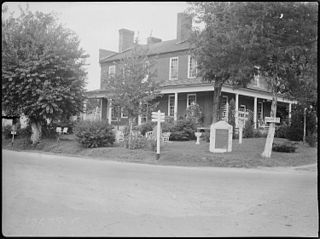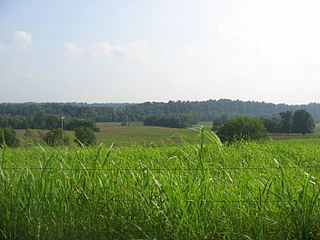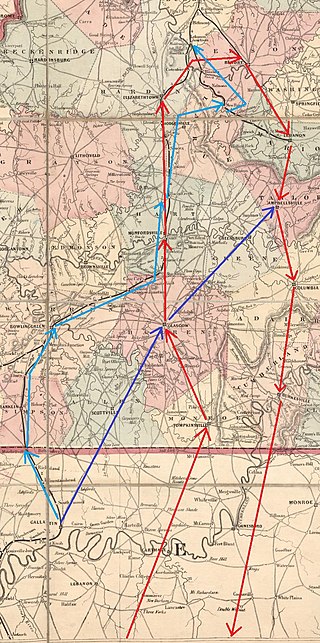
John Hunt Morgan was a Confederate general in the American Civil War. In April 1862, he raised the 2nd Kentucky Cavalry Regiment, fought at Shiloh, and then launched a costly raid in Kentucky, which encouraged Braxton Bragg's invasion of that state. He also attacked General William Rosecrans's supply lines. In July 1863, he set out on a 1,000-mile raid into Indiana and Ohio, taking hundreds of prisoners. But after most of his men had been intercepted by U.S. Navy gunboats, including the USS Moose, Morgan surrendered at Salineville, Ohio, the northernmost point ever reached by uniformed Confederates. Morgan carried out the diversionary "Morgan's Raid" against orders, which gained no tactical advantage for the Confederacy while losing the regiment. Morgan escaped prison, but his credibility was so low that he was restricted to minor operations. He was killed at Greeneville, Tennessee, in September 1864. Morgan was the brother-in-law of Confederate general A. P. Hill. Various schools and a memorial are dedicated to him.

The Battle of Perryville, also known as the Battle of Chaplin Hills, was fought on October 8, 1862, in the Chaplin Hills west of Perryville, Kentucky, as the culmination of the Confederate Heartland Offensive during the American Civil War. Confederate Gen. Braxton Bragg's Army of Mississippi initially won a tactical victory against primarily a single corps of Maj. Gen. Don Carlos Buell's Union Army of the Ohio. The battle is considered a strategic Union victory, sometimes called the Battle for Kentucky, since Bragg withdrew to Tennessee soon thereafter. The Union retained control of the critical border state of Kentucky for the remainder of the war.

Richard Montgomery Gano was a physician, Protestant minister, and brigadier general in the army of the Confederate States during the American Civil War.

The Battle of Bean's Station was fought in Grainger County, Tennessee, during the Knoxville campaign of the American Civil War. The action saw Confederate forces commanded by Lieutenant General James Longstreet attack Union Army cavalry led by Brigadier General James M. Shackelford. After a clash that lasted until nightfall, Longstreet's troops compelled the Federals to retreat. Two cavalry columns that were intended to envelop Shackelford's force were unable to cut off the Union cavalry, though one of the columns captured 25 Federal wagons. On December 15, Shackelford was joined by some Union infantry southwest of Bean's Station where they skirmished with the Confederates before withdrawing again.
The Battle of Hartsville was fought on December 7, 1862, in northern Tennessee at the opening of the Stones River Campaign the American Civil War. Hartsville Battlefield is listed on the National Register of Historic Places.
The First Battle of Murfreesboro was fought on July 13, 1862, in Rutherford County, Tennessee, as part of the American Civil War. Troops under Confederate cavalry commander Brig. Gen. Nathan Bedford Forrest surprised and quickly overran a Federal hospital, the camps of several small Union units, and the jail and courthouse in Murfreesboro, Tennessee. All of the Union units surrendered to Forrest, and the Confederates destroyed much of the Union's supplies and destroyed railroad track in the area. The primary consequence of the raid was the diversion of Union forces from a drive on Chattanooga.

The Battle of Cove Mountain occurred in Wythe County, Virginia, on May 10, 1864, during the American Civil War. A Union cavalry division commanded by Brigadier General William W. Averell was prevented from attacking a lead mine located near Wytheville. Confederate forces commanded by Brigadier General John Hunt Morgan, with a detachment of a brigade of cavalry from the command of Brigadier General William E. "Grumble" Jones, stopped Averell at Cove Gap, adjacent to Crockett's Cove and Cove Mountain.

The siege of Corinth was an American Civil War engagement lasting from April 29 to May 30, 1862, in Corinth, Mississippi. A collection of Union forces under the overall command of Major General Henry Halleck engaged in a month-long siege of the city, whose Confederate occupants were commanded by General P.G.T. Beauregard. The siege resulted in the capture of the town by Federal forces.

Morgan's Raid was a diversionary incursion by Confederate cavalry into the Union states of Indiana, Kentucky, Ohio, and West Virginia during the American Civil War. The raid took place from June 11 to July 26, 1863. It is named for the commander of the Confederate troops, Brigadier General John Hunt Morgan. Although it caused temporary alarm in the North, the raid failed.

The Battle of Corydon was a minor engagement that took place July 9, 1863, just south of Corydon, which had been the original capital of Indiana until 1825, and was the county seat of Harrison County. The attack occurred during Morgan's Raid in the American Civil War as a force of 2,500 cavalry invaded the North in support of the Tullahoma Campaign. It was the only pitched battle of the Civil War that occurred in Indiana, and no battle has occurred within Indiana since.

The Battle of Tebbs Bend was fought on July 4, 1863, near the Green River in Taylor County, Kentucky during Morgan's Raid in the American Civil War. Despite being badly outnumbered, elements of the Union Army defeated Confederate Brig. Gen. John Hunt Morgan's dismounted cavalry.

Kentucky was a southern border state of key importance in the American Civil War. It officially declared its neutrality at the beginning of the war, but after a failed attempt by Confederate General Leonidas Polk to take the state of Kentucky for the Confederacy, the legislature petitioned the Union Army for assistance. Though the Confederacy controlled more than half of Kentucky early in the war, after early 1862 Kentucky came largely under U.S. control. In the historiography of the Civil War, Kentucky is treated primarily as a southern border state, with special attention to the social divisions during the secession crisis, invasions and raids, internal violence, sporadic guerrilla warfare, federal-state relations, the ending of slavery, and the return of Confederate veterans.

Louisville in the American Civil War was a major stronghold of Union forces, which kept Kentucky firmly in the Union. It was the center of planning, supplies, recruiting and transportation for numerous campaigns, especially in the Western Theater. By the end of the war, Louisville had not been attacked once, although skirmishes and battles, including the battles of Perryville and Corydon, Indiana, took place nearby.

The Battle of Cynthiana, or more specifically the Second Battle of Cynthiana or the Battle of Kellar's Bridge, included three separate engagements during the American Civil War that were fought on June 11 and 12, 1864, in Harrison County, Kentucky, in and near the town of Cynthiana. This was part of Confederate Brigadier General John H. Morgan's 1864 Raid into Kentucky. The battle ultimately resulted in a victory by Union forces over the raiders and ended Morgan's Last Kentucky Raid in defeat. Morgan's command had previously captured the town in the First Battle of Cynthiana, July 17, 1862.

The Confederate Monument in Glasgow, Kentucky, built in 1905 by the Kentucky Women's Monumental Association and former Confederate soldier John A. Murray, commemorates those who gave their lives in service for the Confederate States of America. It is located on the side of Glasgow's courthouse. The Confederate soldier, made of bronze, is at parade rest, and features details such as a bedroll, canteen, kepi hat, and rifle. It stands on a limestone pedestal.
The 1st Kentucky Cavalry Regiment was a cavalry regiment that served in the Union Army during the American Civil War.

The Battle of Augusta was an engagement during the American Civil War that took place on September 27, 1862, in Augusta, Kentucky, between the Bracken County Home Guard (Union) and the Confederate Second Kentucky Cavalry Regiment under command of Colonel Basil W. Duke, a brother-in-law of John H. Morgan. The skirmish resulted in a victory for the Confederacy but the number of Confederate casualties and lack of ammunition for his artillery caused Colonel Duke to abandon plans to cross over the Ohio River into Ohio. A result of the fighting was that twenty buildings were set on fire and destroyed.

The Battle of Riggins Hill was a minor engagement in western Tennessee during the American Civil War. A Confederate raiding force under Colonel Thomas Woodward captured Clarksville, Tennessee, threatening Union shipping on the Cumberland River. Several Union regiments led by Colonel William Warren Lowe advanced from nearby Fort Donelson and drove off the Confederates after a struggle lasting less than an hour. The action occurred during the Confederate Heartland Offensive but only affected the local area.

The Battle of Philadelphia saw the Confederate cavalry brigades of Colonels J. J. Morrison and George Gibbs Dibrell attack a Union cavalry brigade under Colonel Frank Wolford at Philadelphia, Tennessee, during the Knoxville campaign of the American Civil War. While Dibrell's brigade skirmished with Wolford's cavalrymen, Morrison led his brigade around the west side of Philadelphia to attack the Union force from the rear. Wolford sent half his brigade to counter Morrison's envelopment, but Dibrell's soldiers suddenly attacked. The Confederates completely routed Wolford's troopers, capturing over 400. A Union infantry-cavalry force reoccupied Philadelphia the next day, but a week later it withdrew to the north bank of the Tennessee River, abandoning Loudon, Tennessee.

Morgan's Christmas Raid was carried out by Confederate Brigadier General John Hunt Morgan between December 22, 1862, and January 5, 1863. Morgan intended to cut the supply lines to the Union Army of the Cumberland in Tennessee. The Union used the Louisville and Nashville Railroad, and Morgan had identified two 500-foot (150 m) long trestle bridges at Muldraugh Hill that could be burnt. Morgan's 4,000-strong cavalry force left Alexandria, Tennessee, on December 22 and passed into Kentucky on Christmas Eve, defeating part of the 2nd Michigan Cavalry Regiment near Tompkinsville. They fought and defeated an Indiana cavalry detachment on Christmas Day at Bear Wallow, Barren County. The U.S. Army sent forces under Colonel John Marshall Harlan and Major General Joseph J. Reynolds to try to catch Morgan. However, Morgan used ruses to distract his pursuers. Morgan captured a Union stockade at Bonnieville on December 26 and on December 27 captured Elizabethtown before burning the bridges at Muldraugh Hill.
















